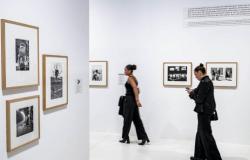Based on her own life and her passion for olfaction, author and perfume journalist Sarah Bouasse maps this “lower” sense of smell in “Through the tip of the nose – an intimate history of smells”. A declaration of love to our noses and to the millions of molecules that enter them.
“Opening your nostrils is simply listening to this particular way that the world appears to us.” From the first pages of “Through the tip of the nose – an intimate history of smells”, we know that smell, this very complex sense, cannot be defined by a precise vocabulary, unlike oenology.
There are the “accords” of perfumes, and the famous “notes”. There is also the olfactory “voice” of these smells which are like “background noise”. But how can we talk about what is perceived so differently depending on each person, their environment, their experience, their culture?
In this work which is “neither really an essay, nor frankly a story”, the nose is put back in the middle of the face (village?). Capable of short-circuiting reason, to the great dismay of Greek philosophers (already), science shows today that he is probably the great master of our decision-making.
3% of our genome is dedicated to olfactory receptors (…), the largest family of genes after that of the immune system.
Stamp
Everything happens on a mucous membrane no larger than a (French) postage stamp, called the olfactory epithelium and lined with millions of neurons. If Homo and Femina Sapiens are equipped with such an organ, it is probably because in the past, on four legs, it was necessary to track, detect, recognize, in order to mate or escape. Which led us to associate smell and emotion.
The more intense it is, the more powerful the memory encoding is. Logic: who says strong emotion, says lesson to be learned.
Without following the philosophy of Andy Warhol (who changed perfume every three months in order to have a clear memory of each trimester by sniffing the corresponding scent), we all have a personal catalog of comfort scents. . However, no region of the world has the same benchmarks: for example, isovaleric acid can evoke a good old parmesan here as much as the smell of feet there. If it is indeed the same molecule, it all depends on the context in which it arrives in your siskin. One smell, however, is unanimous among everyone: that of vanilla, one of the molecules of which recalls the smell of breast milk.
To feel is to converse with oneself
Feel. A verb that is both passive and active, which designates as much what enters our nostrils as what emanates from us. In this regard, Sarah Bouasse highlights the extent to which we are no longer aware of all the smells that make us us and that we believe we hide with toothpaste and perfume. “Our smell is a mille-feuille of which we only control certain layers,” she enjoys writing.
What we cannot control, we hide? This is perhaps one of the reasons for the invisibility of the sense of smell: “As if somewhere deep within ourselves, we fear that by dint of leading us by the tip of the nose, odors will interfere with the idea that we have of our freedom and that we therefore simply prefer to ignore them. The solution? Go there at a moment’s notice, and simply learn to listen to your nose.
Ellen Ichters/olhor
Sarah Bouasse, “Through the tip of the nose – an intimate history of smells”, ed. Calmann-Lévy, May 2024.
Do you like to read? Subscribe to QWERTZ and receive every Friday this newsletter dedicated to book news prepared by RTS Culture.






